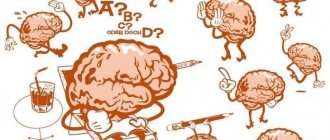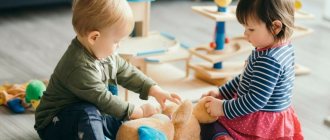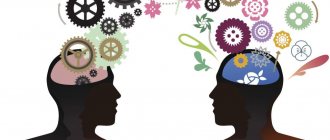The mental development of a child is a very complex, subtle and lengthy process, which is influenced by many factors.
An idea of how this or that stage goes will help you not only better understand your child, but also notice developmental delays in time and take appropriate measures. The generally accepted periodization of the development of the child’s psyche was developed by the Soviet psychologist Daniil Borisovich Elkonin. Even if you have never encountered his works, this system is familiar to you: in the annotations to children's publications it is often indicated that this work is “for preschool age” or “for primary schoolchildren.”
Elkonin’s system describes the mental development of a child from infancy to 15 years, although in some of his works the age of 17 years is indicated.
According to the scientist, the characteristics of each stage of development are determined by the leading activity of the child at a particular age, within the framework of which certain mental new formations appear.
Infancy
This stage covers the period from birth to one year. The leading activity of the baby is communication with significant figures, that is, adults. Mainly mom and dad. He learns to interact with others, express his desires and respond to stimuli in ways accessible to him - intonation, individual sounds, gestures, facial expressions. The main goal of cognitive activity is knowledge of relationships.
The task of parents is to teach the child to “communicate” with the outside world as quickly as possible. Games for the development of large and fine motor skills and the formation of a color scheme will help with this. Among the toys there must be objects of various colors, sizes, shapes, textures. Until one year, the child does not experience any experiences other than natural ones: hunger, pain, cold, thirst, and is not able to learn the rules.
Attention
Attention ? This is a mental process that ensures the concentration of consciousness on some object. It helps to identify the most important for a person from a large flow of information.
Taking into account the child’s mental processes and the participation or non-participation of the will, we can distinguish between voluntary and involuntary attention. The involuntary (also called passive) arises spontaneously, it does not depend on a person’s intentions, while the voluntary has a conscious goal.
Involuntary attention during the period of senior preschool childhood dominates over voluntary attention; the child still does not know how to control his attention and most often it depends on external impressions. The child is still quickly distracted and cannot concentrate on one object for a long time.
At the age of 5-6 years, children begin to develop voluntary attention, no longer at the direction of an adult, but under the influence of self-instruction (a preschooler regulates this process with the help of internal speech). Voluntary attention increases as its main properties develop (concentration, volume, etc.) and by the age of seven, children already maintain their attention on objects that are intellectually important to them.
Senior preschool age is characterized by such mental processes of the child as the transition from involuntary attention to voluntary attention. This is a very important and significant period for the child’s psyche.
At this time, children can hold their attention on a picture for about ten minutes, switch it from one object to another, and divide it between several objects. During games, for example, children can play with several toys. This indicates that attention span is increasing.
During the period of preschool childhood, the child’s mental processes are such that the stability of attention is still small, children cannot maintain interest in the same subject for a long time, but by older preschool age, stability increases significantly. This can be seen in games. If at a younger preschool age children can play the same game for only half an hour, then at an older age this time increases to two hours.
A child, under the guidance of an adult, can do work that is quite uninteresting for him, if he understands that this work is necessary and must be completed. He is not distracted even by work that is more interesting to him until he finishes what he started. It also happens that work that is initially uninteresting for a preschooler becomes interested in him and becomes exciting.
The development of attention properties in older preschool age is associated with changes in the organization of life. In addition to the game, such types of activities as educational and work appear.
As a conclusion, we highlight the features of attention characteristic of this age period:
- the volume of attention increases (the child is already able to reproduce up to several objects at once);
- stability increases due to interest in learning and cognitive activity;
- Children have little practical experience, so the ability to quickly switch and distribute is poorly developed;
A child at this age cannot yet hold attention for a long time, but this characteristic is already orders of magnitude higher than in primary and secondary preschool age.
Early childhood
It lasts from 1 year to 3 years. The leading activity is manipulative-objective activity. The child discovers many objects around him and strives to explore them as quickly as possible - taste them, break them, etc. He learns their names and makes his first attempts to take part in the conversation of adults.
Mental new formations are speech and visual-effective thinking, that is, in order to learn something, he needs to see how this action is performed by one of the elders. It is noteworthy that at first the child will not play independently, without the participation of mom or dad.
Features of the early childhood stage:
- comprehension of the names and purposes of objects, mastering the correct manipulation of a specific object;
- mastering established rules;
- the beginning of awareness of one’s own “I”;
- the beginning of the formation of self-esteem;
- gradual separation of one’s actions from the actions of adults and the need for independence.
Early childhood often ends with the so-called crisis of 3 years, when the child sees pleasure in disobedience, becomes stubborn, literally rebels against established rules, sharp negative reactions increasingly appear, etc.
Study methods
In the field of psychiatry and cognitive science, the following methods are used to study the processes of memory, perception, thinking, attention and other functions:
- Recognizing figures by touch and manipulating them tactilely (Seguin board).
- Visual recognition of real, noisy, contour and defocused images (Poppelreiter test).
- Perception of objects requiring visual-spatial processing (contour geographical map, schematic clock).
- Recognizing familiar portraits of famous people.
- Listening perception and assessment of rhythmic structures.
- Detection of memory impairments (Pictogram technique).
It should be said that it is possible to identify a violation of the mental process only with the help of several methods, that is, problems need to be diagnosed in a complex manner.
The largest number of techniques explore thinking. The most famous is “Classification of Objects”, where it is possible to study various aspects of the thinking process. Also known: understanding the figurative meaning of metaphors and proverbs, solving arithmetic problems of varying degrees of complexity, comparing and defining concepts.
Now let's talk separately about the course of mental processes and states, their characteristics, properties and functions.
Preschool age
This stage begins at 3 years and ends at 7 years. The leading activity for preschoolers is play, or rather, role-playing game, during which children learn relationships and consequences. The personal sphere of the psyche is actively developing. Age-related neoplasms are a need for social significance and activity.
The child can move independently, his speech is understandable to adults, and he often feels like a full participant in communication.
- He understands that all actions and actions have a specific meaning. When teaching, for example, hygiene rules, explain why this is necessary.
- The most effective way to absorb information is through play, so role-playing games should be played every day. In games, you should not use real objects, but their substitutes - the simpler the better for the development of abstract thinking.
- The preschooler experiences an urgent need to communicate with peers and learns to interact with them.
Towards the end of the stage, the child gradually gains independence, is able to determine the cause-and-effect relationship, is able to take responsibility for his actions, and obeys the rules if he sees them as reasonable. He learns good habits, rules of politeness, norms of relationships with others, strives to be useful, and willingly makes contact.
Imagination
Imagination is the ability to mentally reproduce something, create new images using combinations of already known facts and manipulate them.
The development of imagination helps a child to better understand the world, develop successfully, effectively solve problems, and accumulate life luggage. These functions are very important for children, and therefore the ability to imagine should be actively developed.
Affective imagination in children helps to get rid of unpleasant experiences and their own negative qualities by attributing and projecting them to other people or even objects.
At 6-7 years old, a child’s affective imagination is already so developed that he can create his own world with imaginary characters and live in it, communicating with imaginary friends and enemies. The creative process in children is often projected onto other objects and phenomena, and the stage of stable experiences develops. Children create fantastic works that reflect their experiences; they actively seek ways to communicate these experiences.
The alternativeness of using these methods is expressed in the selection of identical methods for applying the results of imagination, in the method of conveying the idea, as well as in the search for a plan.
Holistic judgments about objects and phenomena are already created by the method of inclusion, when each individual element of reality participates in the creation of a single integral image; at this time the elements are not in the main place, but in a secondary place.
At this age, children know how to plan - before the start of an activity, a plan for carrying out the work is created, which is consistently put into action and can even be corrected during implementation.
However, without observation and control, without encouraging initiatives on the part of adults, a child cannot fully develop his imagination and will not be able to direct it in the right direction.
If the affective imagination operates without easy tolerance of mental trauma, then this can lead to pathology, to long-term deep experiences in the form of autism; a child can completely escape into a fantasy world, replacing real facts with imaginary ones.
Cognitive imagination in children is characterized by gradual decline, because this mental activity exists and manifests itself in very uncertain situations, the number of which gradually decreases as children grow older.
Junior school age
This stage lasts from 7 to 11 years and is associated with significant changes in the child’s life and behavior. He enters school, and play activities give way to educational activities. The intellectual and cognitive sphere is actively developing. Age-related mental neoplasms: voluntariness, internal plan of action, reflection and self-control.
What does it mean?
- He is able to concentrate for a long time on a specific lesson: sit quietly at his desk during a lesson and listen to the teacher’s explanations.
- Able to plan and perform tasks in a certain sequence, for example, when doing homework.
- He determines the boundaries of his knowledge and identifies the reason why, for example, he cannot solve a problem, what exactly is missing for this.
- The child learns to control his actions, for example, first do his homework, then go for a walk.
- He experiences discomfort from the fact that an adult (teacher) cannot give the amount of attention that he is used to receiving at home.
A younger student can more or less accurately assess the changes that have occurred in his personality: what he could do before and what he can do now, learns to build relationships in a new team, and obey school discipline.
The main task of parents during this period is to emotionally support the child, closely monitor his mood and feelings, and help him find new friends among classmates.
Memory
Memory plays a big role in the full development of older preschoolers. Thanks to this process, the child is able to acquire knowledge about what surrounds him in everyday life and learn about his own personality. It is thanks to memory that they master behavioral norms and acquire new and useful skills and habits.
A five-year-old preschooler can trace his own mental processes as a child, and significant changes in memory can already be observed. A child of senior preschool age expands his horizons, knowledge, and skills; all this indicates quantitative and qualitative changes in the preschooler’s memory. At this age, a child begins to develop the inclinations of voluntary memory. Children aged five and six years are already able to clearly identify a mnemonic goal. This is possible when memorizing and recalling something.
We also note the formation and development of self-control skills in older preschoolers when they need to remember visual or verbal material. And self-control is a kind of incentive for children to master logical memorization techniques. In older preschool age, we can already talk about the development of visual-figurative memory. This is facilitated by the development of other mental processes, in particular thinking.
Adolescence
This is the “transitional age”, which lasts from 11 to 15 years and the onset of which all parents await with horror. The leading activity is communication with peers, the desire to find one’s place in the group, receive its support and at the same time stand out from the crowd. The need-motivational sphere of the psyche develops mainly. Mental neoplasms – self-esteem, desire for “adulthood”.
The teenager is torn between the desire to grow up quickly and to maintain a certain impunity for as long as possible, to relieve himself of responsibility for his actions. He learns about the system of relations between the sexes, tries to build his own, rebels against prohibitions and constantly breaks the rules, fiercely defends his point of view, seeks his place in the world and at the same time amazingly easily falls under the influence of others.
Some guys, on the contrary, immerse themselves in their studies, their transitional age is, as it were, “transferred” to a later time, for example, they may well begin their rebellion even after graduating from university.
Parents face a difficult task - to find a common language with a teenager in order to protect him from rash actions.
Mental emotional processes
Let's consider each process separately.
1
Feelings
Feeling is a human emotional process that reflects a subjective evaluative attitude towards abstract or real objects. Feelings manifest differently among people because they are influenced by their own set of individual traits and personality traits. Necessary for communication, friendship and understanding of other people.
Properties of feelings:
- Content: reflection of various aspects, features of the meaning of the objects that cause them.
- Sthenicity: sthenic feelings mobilize a person’s strength, encourage him to active activity (hate, love). Asthenic paralyzes and relaxes (contempt and fear).
- Intensity: strength of feeling.
- Valence: pleasant, unpleasant and ambivalent feelings.
2
Emotions
Emotions reflect a subjective evaluative attitude towards objects, phenomena, situations and people. With the help of will, a person can evoke any emotion that he deems necessary.
The properties of emotions completely coincide with the properties of feelings.
3
Stress
Stress is a set of adaptive reactions of the psyche to stressors.
There is positive (eustress) and negative (distress) stress. The difference is in intensity: the more of it in the psyche, the worse.
4
Affects
Affects are emotional processes of an explosive nature. In many cases they are considered a negative manifestation of the psyche, but in a threatening situation they can save lives.
Adolescence
Some psychologists identify another stage of mental development - this is adolescence, from 15 to 17 years. Educational and professional activities become the leading ones. Personal and cognitive spheres develop. During this period, the teenager matures sharply, his decisions become more balanced, he begins to think about the future, in particular, about choosing a profession.
Growing up is difficult at any age - at 3 years old, at 7, and at 15 years old. Parents must understand well the characteristics of their child’s mental development and help him successfully overcome all age-related crises, direct the formation of his character and personality in the right direction.
Date of publication: 06/26/2017. Last modified: 05/09/2018.








